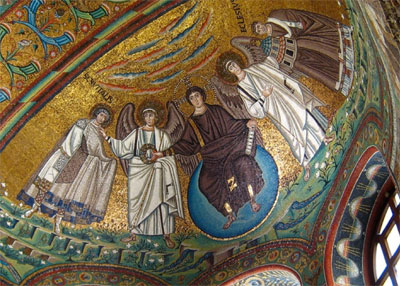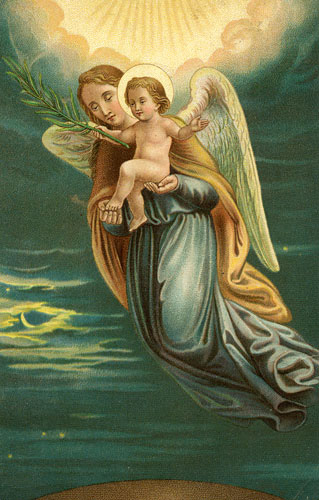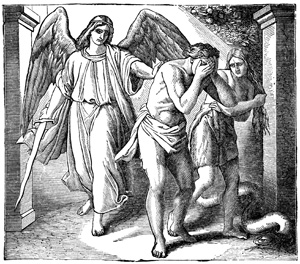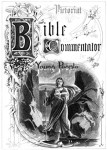By Karen, on November 18th, 2010

Santa Eufemia, Verona – Interior
Raphael is frequently represented without wings when leading Tobias, who — in order to emphasize the contrast between an angel and a mortal — is made very small, and is thus manifestly out of keeping with the story. When the wings appear there is no reason for dwarfing Tobias, and the picture is far more satisfactory. It is not difficult to discern that if the story of Tobias is considered as an allegory, the young man personates the Christian, guided and guarded through life by God’s mercy. . . . → Read More: Archangel Raphael: Part 2
By Karen, on November 14th, 2010
 St. Michael at the Castle of San’ Angelo, Rome by Matthias Kabel St. Michael at the Castle of San’ Angelo, Rome by Matthias Kabel
In the legends of St. Michael we read that in the sixth century, when the plague was raging in Rome, and processions threaded the streets chanting the service since known as the Great Litanies, the Archangel Michael appeared, hovering over the city. . . . → Read More: Archangel Michael: Part 3
By Karen, on October 17th, 2010
 A very ancient Annunciation, of peculiar and elaborate arrangement, dating from the fifth century, is in mosaic, over the arch in front of the choir in the church of Santa Maria Maggiore, in Rome. The classical treatment of the dresses, and of the entire composition, makes this work so different from the usual conception of the subject as to be of observation. There are two scenes: in the first, the archangel is sent on his mission, and is rapidly flying towards the earth, as if in haste to utter his joyous salutation, “Hail! thou art highly favored! Blessed art thou among women!” . . . → Read More: Archangel Gabriel: Part 2 A very ancient Annunciation, of peculiar and elaborate arrangement, dating from the fifth century, is in mosaic, over the arch in front of the choir in the church of Santa Maria Maggiore, in Rome. The classical treatment of the dresses, and of the entire composition, makes this work so different from the usual conception of the subject as to be of observation. There are two scenes: in the first, the archangel is sent on his mission, and is rapidly flying towards the earth, as if in haste to utter his joyous salutation, “Hail! thou art highly favored! Blessed art thou among women!” . . . → Read More: Archangel Gabriel: Part 2
By Karen, on October 3rd, 2010
 Apse Mosaic, San Vitale, Ravenna (Flickr) / CC BY-NC 3.0 Apse Mosaic, San Vitale, Ravenna (Flickr) / CC BY-NC 3.0
The earliest instance of the Archangels introduced by name into a work of art is in the old church of San Michele at Ravenna (A. D. 545). The mosaic in the apse exhibits Christ in the centre, bearing in one hand the cross as a trophy or sceptre, and in the other an open book on which are the words, “Qui cidef me videt et Patrem meum” [John xiv. 9]. On each side stand Michael and Gabriel, with vast wings and long scepters; their names are inscribed above, but without the Sanctus and without the Glory. It appears, therefore, that at this time, the middle of the sixth century, the title of Saint, though in use, had not been given to the Archangels. . . . → Read More: Archangels: Part 2
By Karen, on September 11th, 2010

Triumph of the Innocents by Holman Hunt
[Part 1] [Part 2] [Part 3] In this front rank of great religious artists we must also place Mr. Holman Hunt, whose work has appealed so strongly to the popular mind, without any deliberate attempt on his part, however, to make it do so. His great picture, “The Triumph of the Innocents,” demands mention here for the beauty of the angelic children who, seen alone by the infant Christ, are accompanying the Holy Family to Egypt. The picture was at the Guildhall Exhibition a year or two ago, and is now in the Walker Art Gallery, Liverpool. . . . → Read More: Angel Art: Part 4
By Karen, on September 10th, 2010

Guardian Angels
At the close of the previous article [Angel Art – Part 2] I ventured to express the opinion that we should find the most successful modern artists who have pictured the angelic form to be those who have worked in the same simple spiritual manner as did the Pre-Raphaelite Italian painters. The religious ideal in art has been seldom attained: it demands something more than mere technical skill: the quietude of life, the purity of thought, the calm faith which Fra Angelico cultivated, are needed to produce the proper state of mind to direct the physical power of the work. There have been many modern painters who have set themselves to paint religious pictures, but those to whom success can be attributed are few. . . . → Read More: Angel Art: Part 3
By Karen, on August 22nd, 2010

Heavenly Angels
Bearing these remarks in mind, [Angel Art: Part 1] let us examine the pictorial representations of angels by the early masters in art. It is necessary, too, to remember that Christian art at the first was directed and controlled by the Church. Art was bound to the service of religion: all its life and force were expended upon it, and, indeed, the workers themselves were, for the most part, until the thirteenth century, of the Church. We cannot touch upon the crude productions of the very early artists, and can only barely refer to the culmination of their art as exhibited in illuminated manuscripts. The beauty and delicacy of these decorated parchments are wonderful. With the use of the primary colours and gold, these, to us nameless, workers produced miniature pictures the charm of which—more than six centuries after their creators have passed away—still enthralls us. . . . → Read More: Angel Art: Part 2
By Karen, on August 21st, 2010
 Adam and Eve Pictures Adam and Eve Pictures
From The Quiver, “Picturing the Angels” by Arthur Fish: And He placed at the east of the garden of Eden cherubims, and a flaming sword which turned every way, to keep the way of the tree of life.” This, the first reference in Scripture to the heavenly hosts, brings involuntarily to the mind’s eye of the reader a conception more or less clearly defined of the angelic guardians of the gates of Paradise. From whence has this idea sprung? Not from the Bible itself . . . . . . → Read More: Angel Art: Part 1
By Karen, on August 18th, 2010
 For my very first post, I wanted to share excerpts from two books that eloquently express why Biblical Art can enhance our understanding and appreciation of the Bible.
From The Teachers’ and Students’ Encyclopedia by Patrick Fairbairn:
Special care and attention have been given to the preparation of the illustrations, of which about seven . . . → Read More: Biblical Art
|
|
|
 St. Michael at the Castle of San’ Angelo, Rome by Matthias Kabel
St. Michael at the Castle of San’ Angelo, Rome by Matthias Kabel
 Apse Mosaic, San Vitale, Ravenna
Apse Mosaic, San Vitale, Ravenna




Archangel Raphael: Part 2
Santa Eufemia, Verona – Interior
Raphael is frequently represented without wings when leading Tobias, who — in order to emphasize the contrast between an angel and a mortal — is made very small, and is thus manifestly out of keeping with the story. When the wings appear there is no reason for dwarfing Tobias, and the picture is far more satisfactory. It is not difficult to discern that if the story of Tobias is considered as an allegory, the young man personates the Christian, guided and guarded through life by God’s mercy. . . . → Read More: Archangel Raphael: Part 2